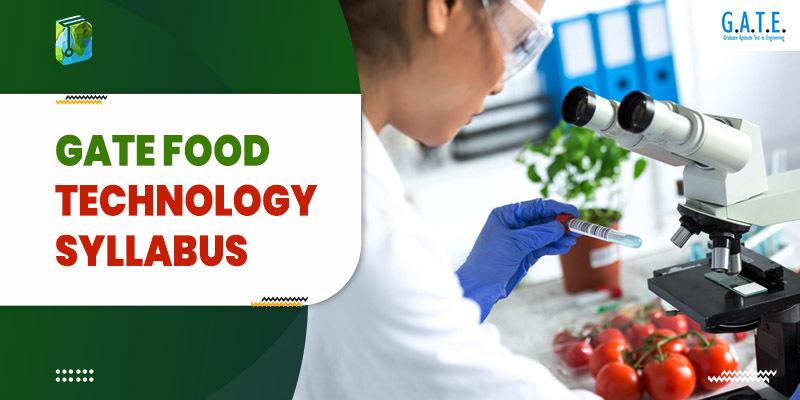This domain deals with the production, preservation, packaging, quality assurance, etc., of food. The candidates who are opting for this branch must be thorough with revising the syllabus. This article will give you complete information regarding the GATE Food Technology Syllabus 2024.
GATE Food Technology Syllabus (XE_G) 2024
GATE Food Technology Syllabus consists of four Sections;
- Food Chemistry and Nutrition.
- Food Microbiology.
- Food Products Technology.
- Food Engineering.
GATE Food Technology Syllabus- Section 1: Food Chemistry and Nutrition
Carbohydrates: The structure and functional properties of mono-, oligo-, and polysaccharides such as starch, cellulose, pectic substances, and dietary fiber, as well as gelatinization and starch retrogradation.
Proteins: classification and structure of proteins in food, biochemical changes in postmortem, and tenderization of muscles.
Lipids: Classification and structure of lipids, rancidity, polymerization, and polymorphism.
Pigments: carotenoids, chlorophylls, anthocyanins, tannins, and myoglobin. Food flavors: terpenes, esters, aldehydes, ketones, and quinines. Enzymes: specificity, simple and inhibition kinetics, coenzymes, enzymatic and nonenzymatic browning.
Nutrition: diet, essential amino acids and essential fatty acids, protein efficiency ratio, water-soluble and fat-soluble vitamins, the role of minerals in nutrition, co-factors, anti-nutrients, nutraceuticals, nutrient deficiency diseases.
Chemical and biochemical changes: Food undergoes changes as a result of various processing methods.
Section 2: Food Microbiology
Characteristics of microorganisms: morphology of bacteria, yeast, mold and actinomycetes, spores and vegetative cells, gram-staining.
Microbial growth: growth and death kinetics, serial dilution technique. Food spoilage: spoilage
microorganisms in different food products including milk, fish, meat, egg, cereals, and their products.
Toxins from microbes: pathogens and non-pathogens including Staphylococcus, Salmonella, Shigella, Escherichia, Bacillus, Clostridium, and Aspergillus genera.
Fermented foods and beverages: curd, yogurt, cheese, pickles, soya sauce, sauerkraut, idli, dosa, vinegar, alcoholic beverages, and sausage.
Section 3: Food Products Technology
Processing principles: thermal processing, chilling, freezing, dehydration, the addition of preservatives and food additives, irradiation, fermentation, hurdle technology, and intermediate moisture foods.
Food packaging and storage: packaging materials, aseptic packaging, controlled and modified atmosphere storage.
Cereal processing and products: milling of rice, wheat, and maize, parboiling of paddy, bread, biscuits, extruded products, and ready-to-eat breakfast cereals.
Oil processing: expelling, solvent extraction, refining, and hydrogenation.
Fruits and vegetable processing: extraction, clarification, concentration, and packaging of fruit juice, jam, jelly, marmalade, squash, candies, tomato sauce, ketchup, and puree, potato chips, pickles.
Plantation crops processing and products: tea, coffee, cocoa, spice, extraction of essential oils and oleoresins from spices.
Milk and milk products processing: pasteurization and sterilization, cream, butter, ghee, ice cream, cheese, and milk powder.
Processing of animal products: drying, canning, and freezing of fish and meat; production of egg powder.
Waste utilization: pectin from fruit wastes, uses of by-products from rice milling.
Food standards and quality maintenance: FPO, PFA, Agmark, ISI, HACCP, food plant sanitation and cleaning in place (CIP)
Section 4: Food Engineering
Mass and energy balance: Flow rate and pressure drop relationships for Newtonian fluids flowing through a pipe, Reynolds number
Heat transfer: heat transfer by conduction, convection, radiation, heat exchangers.
Mass transfer: molecular diffusion and Fick’s law, conduction and convective mass transfer, permeability through single and multilayer films.
Mechanical operations: size reduction of solids, high-pressure homogenization, filtration, centrifugation, settling, sieving, mixing & agitation of liquid.
Thermal operations: thermal sterilization, evaporation of liquid foods, hot air drying of solids, spray and freeze-drying, freezing, and crystallization.
Mass transfer operations: psychrometry, humidification, and dehumidification operations.
Conclusion
During the preparation of the Food Technology examination, we advise you to focus on the GATE Food Technology Syllabus and prepare a strategy accordingly. Additionally, it is important to follow a credible and reliable set of study materials for your preparation. Do not build a stack of books and create unnecessary pressure. Instead, keep relevant books and revise them repeatedly.
Do not lose focus and maintain a healthy lifestyle.
We wish you the best in everything!
People are also reading:

